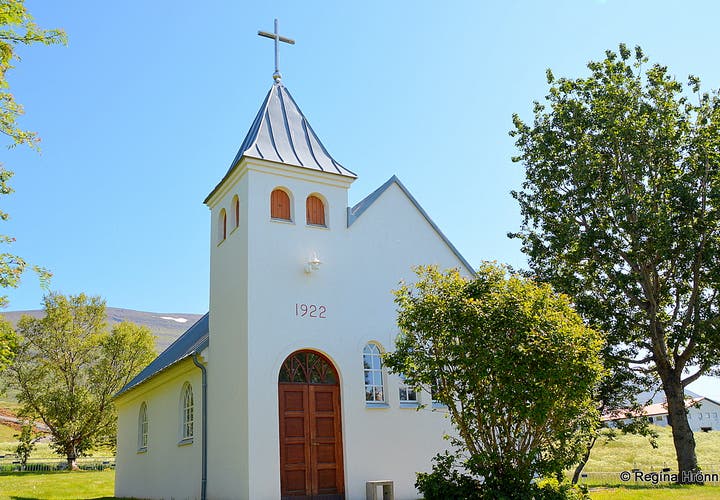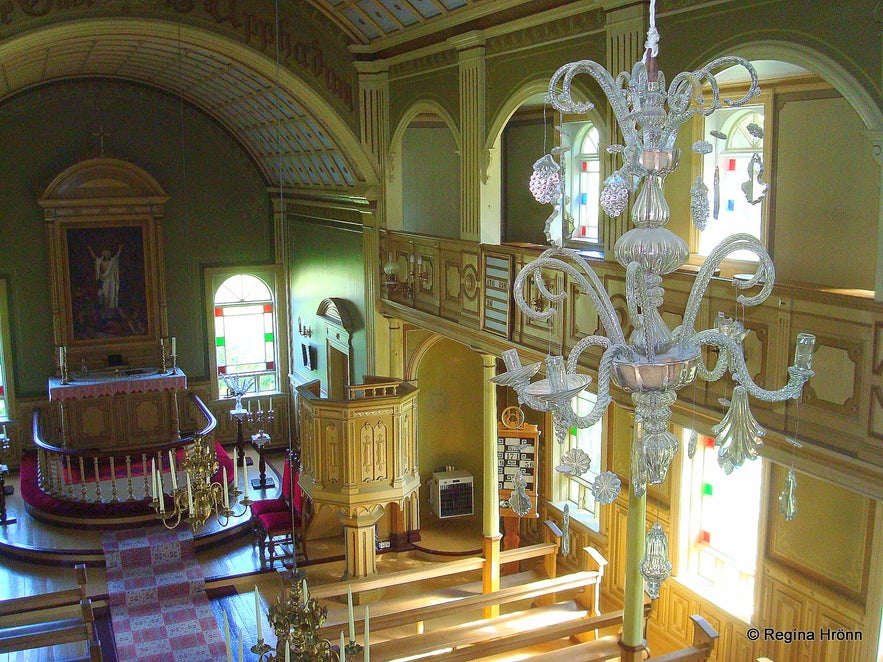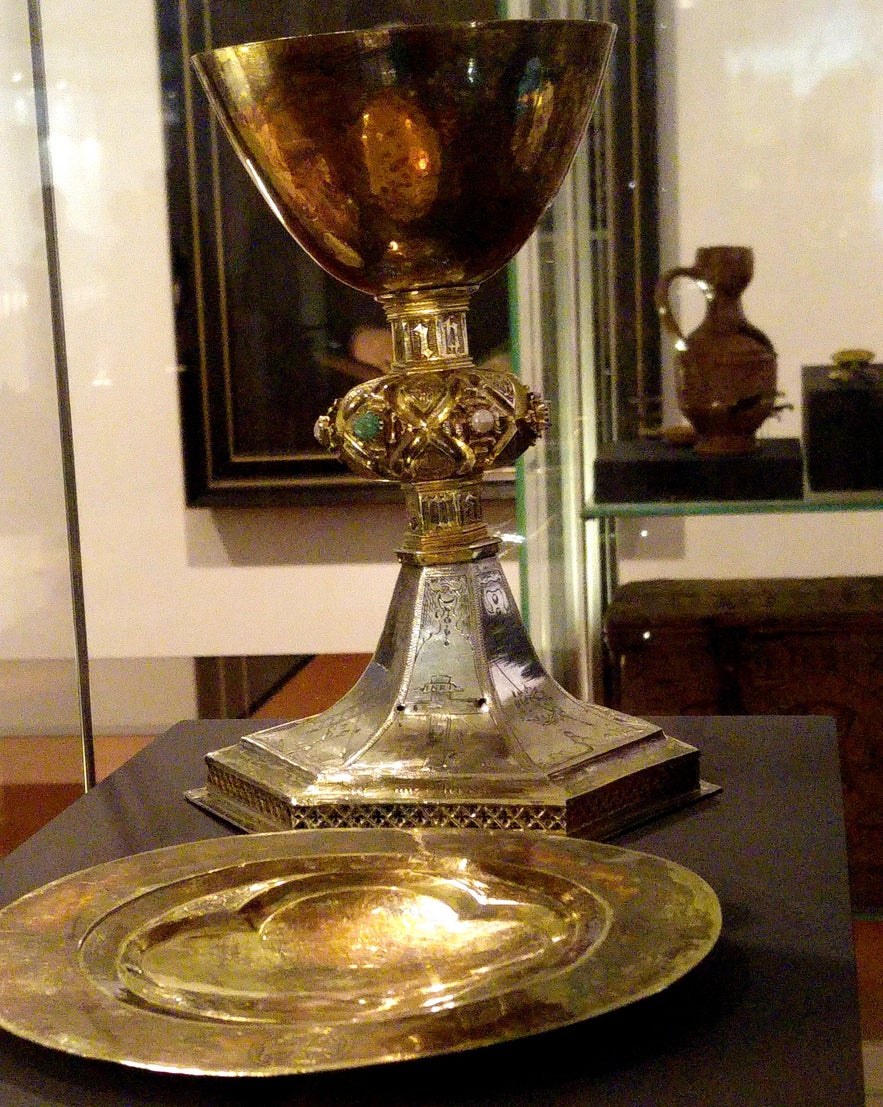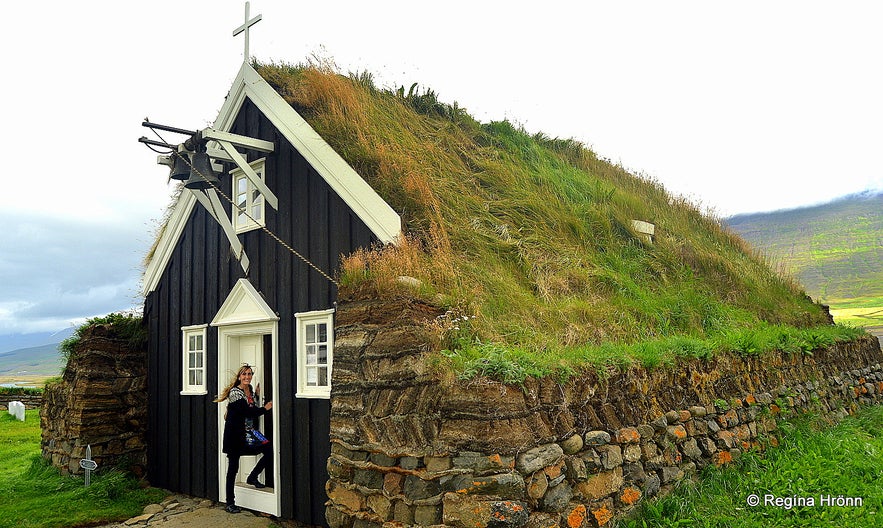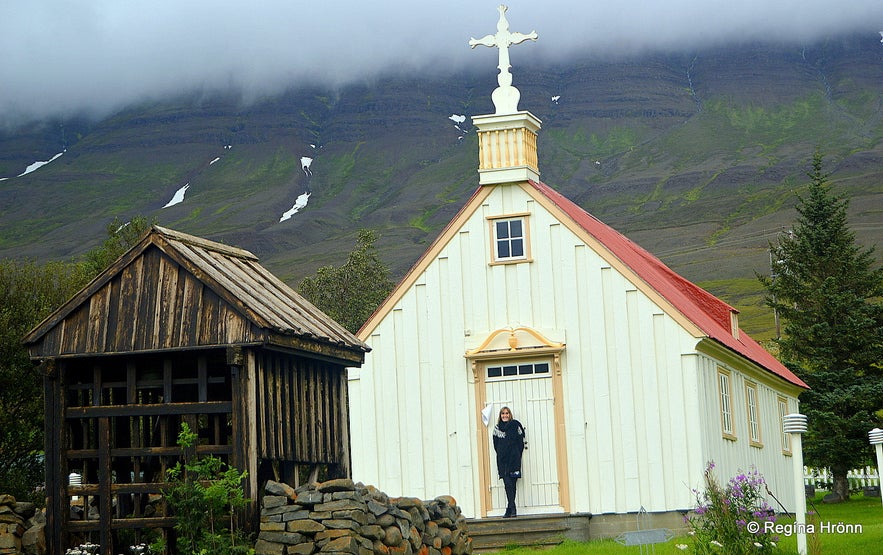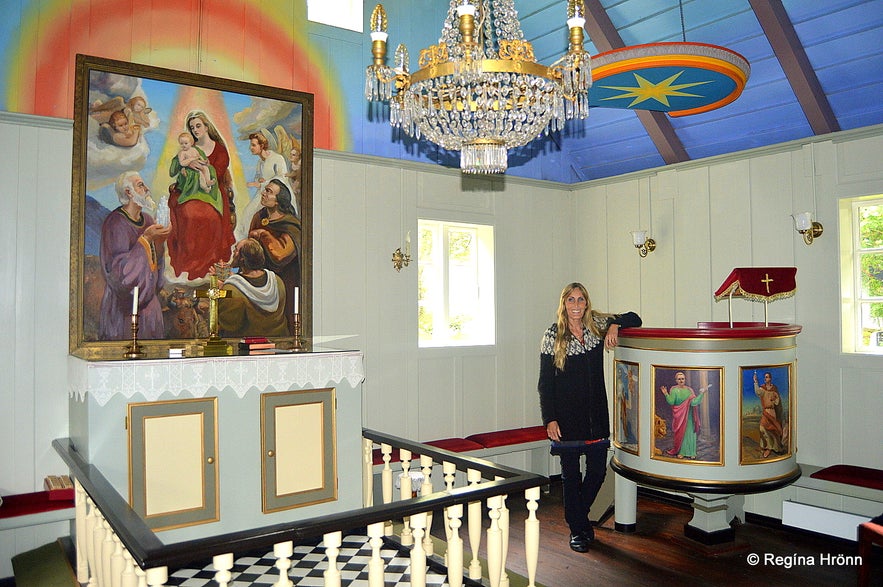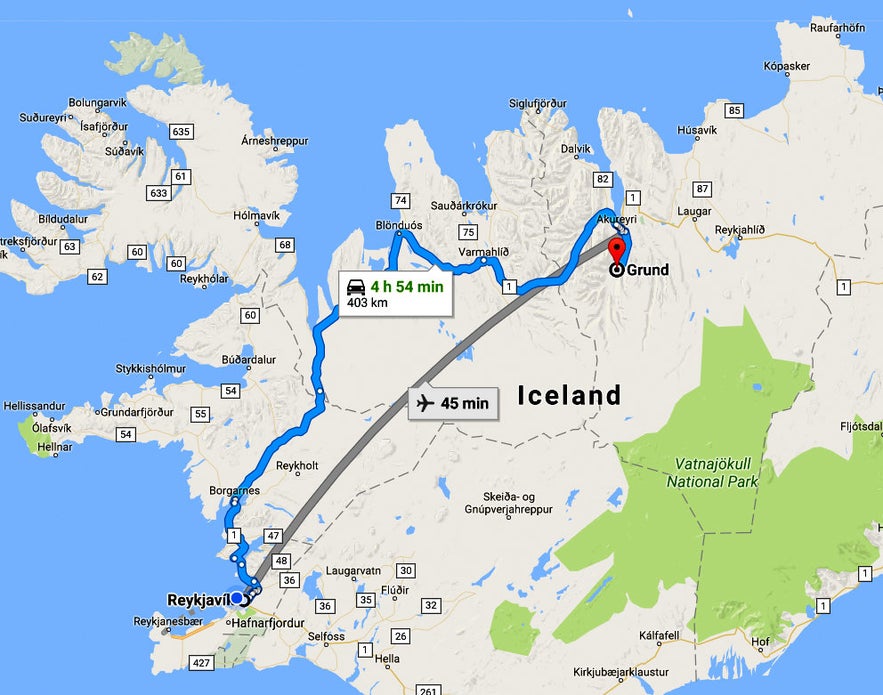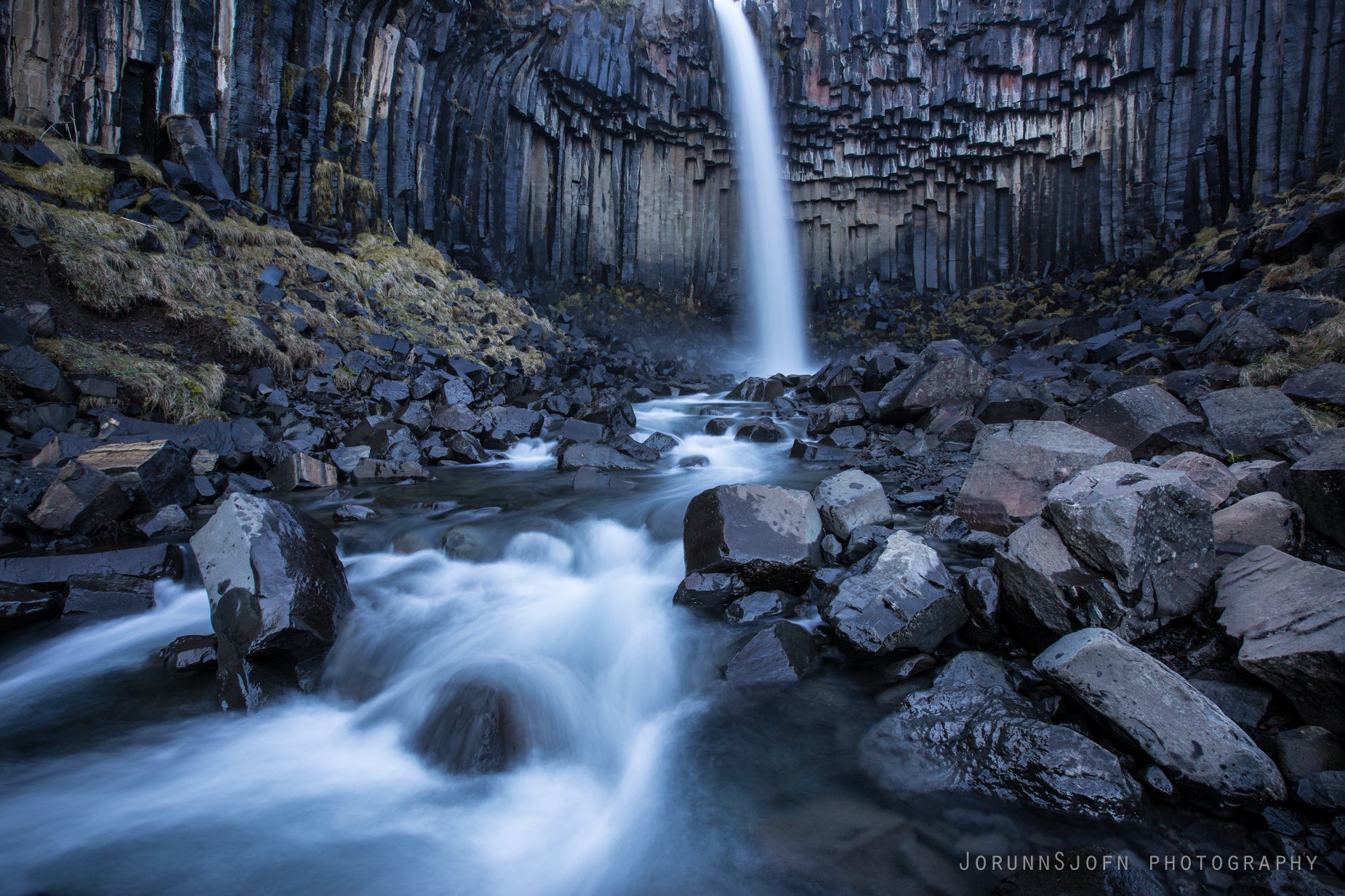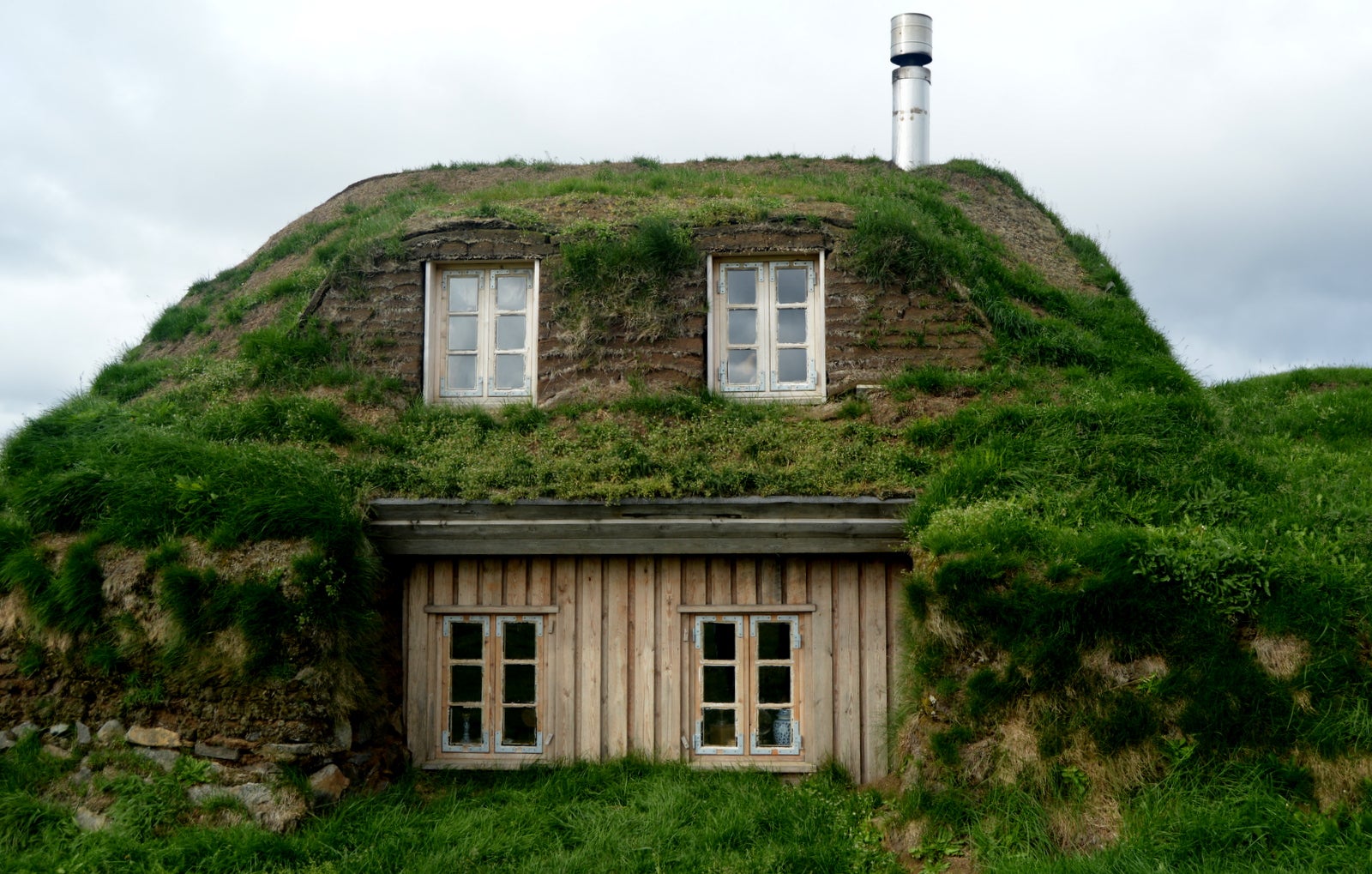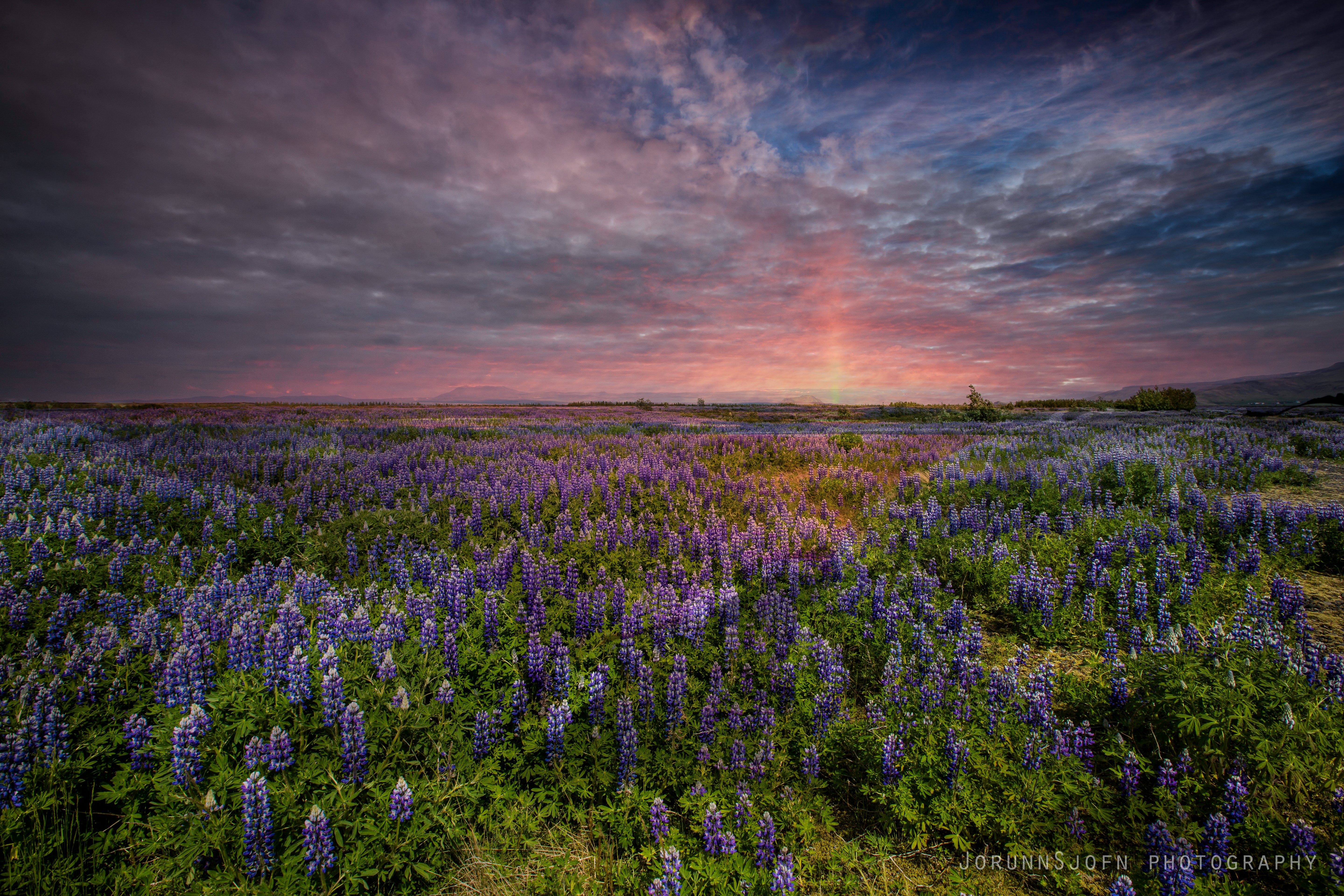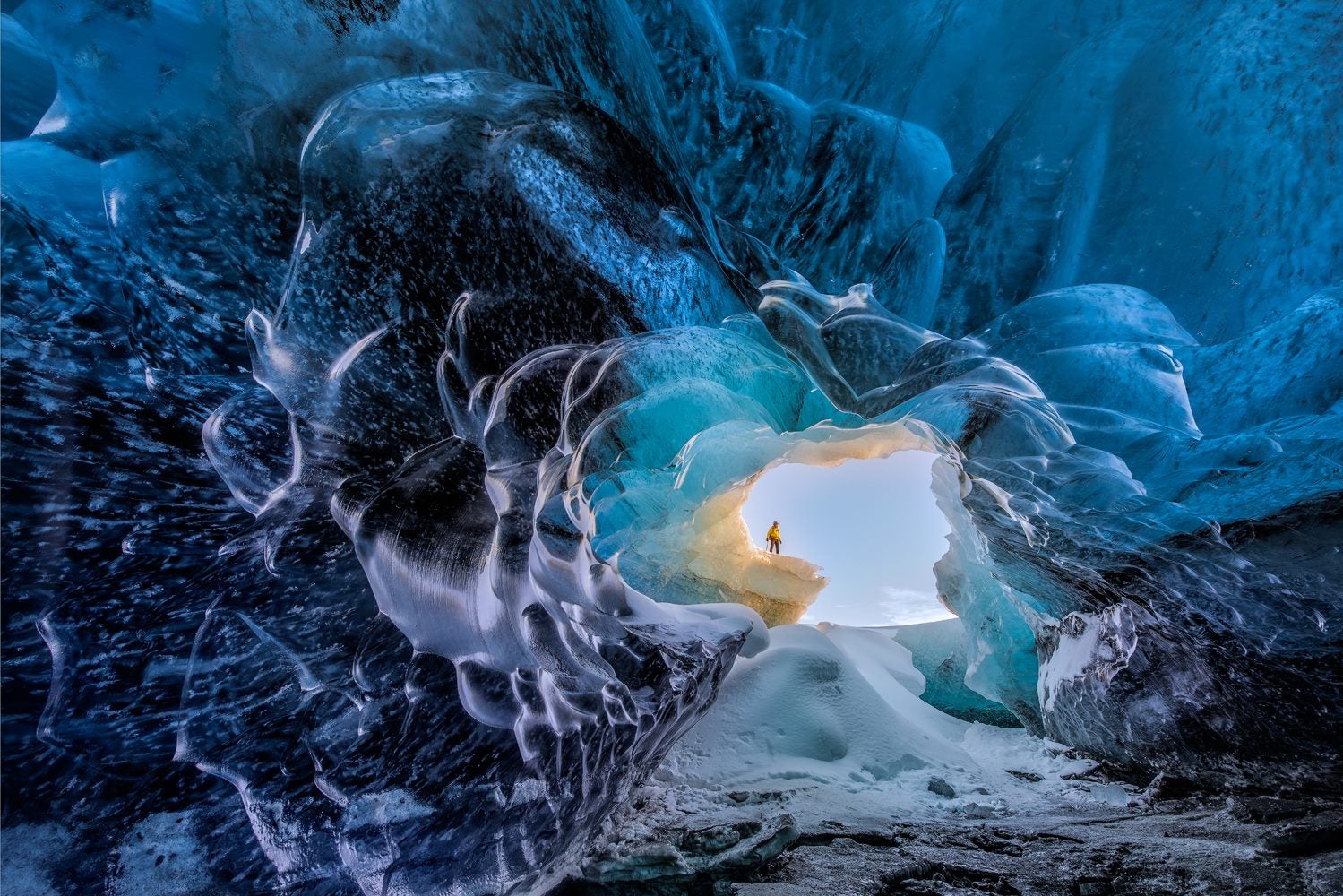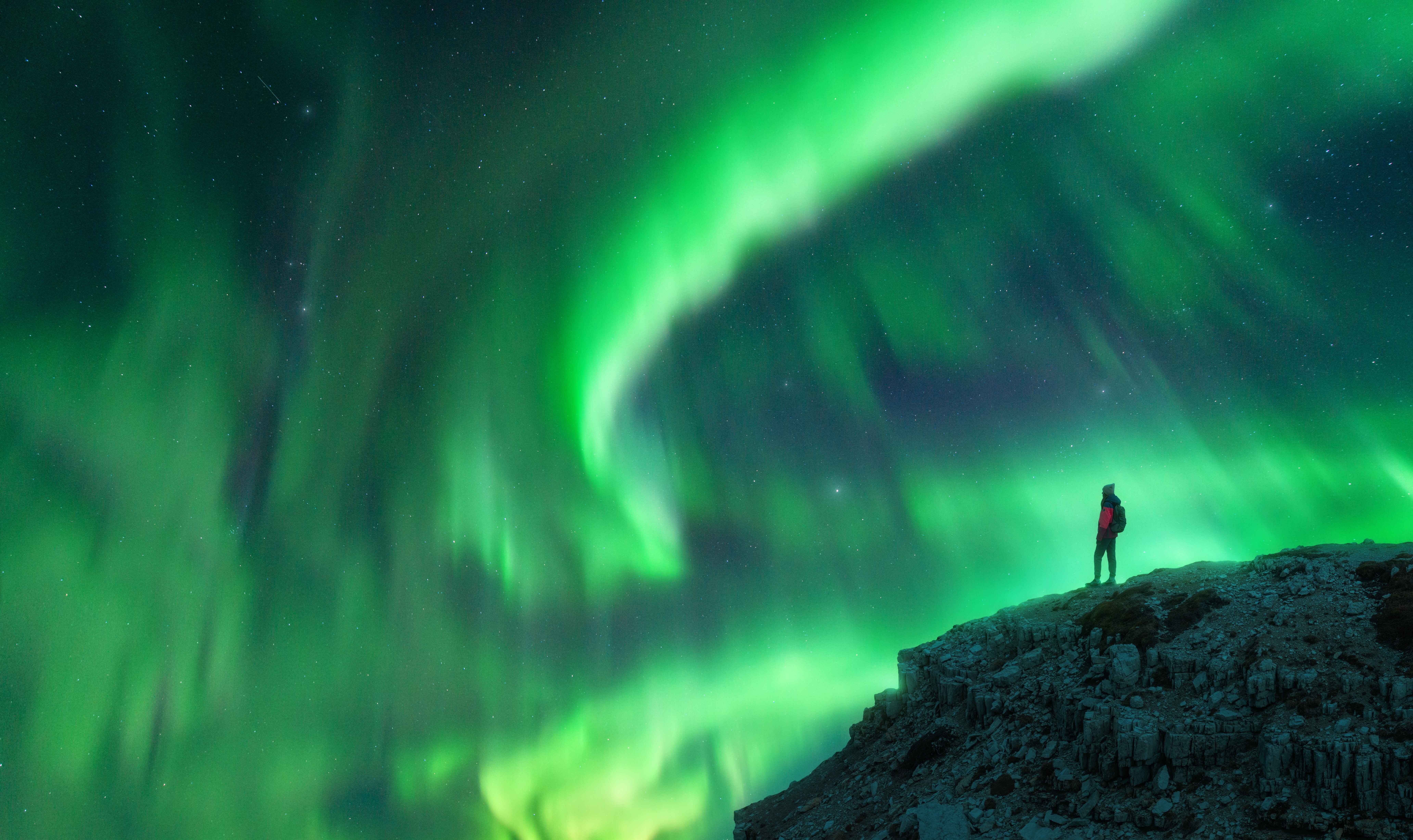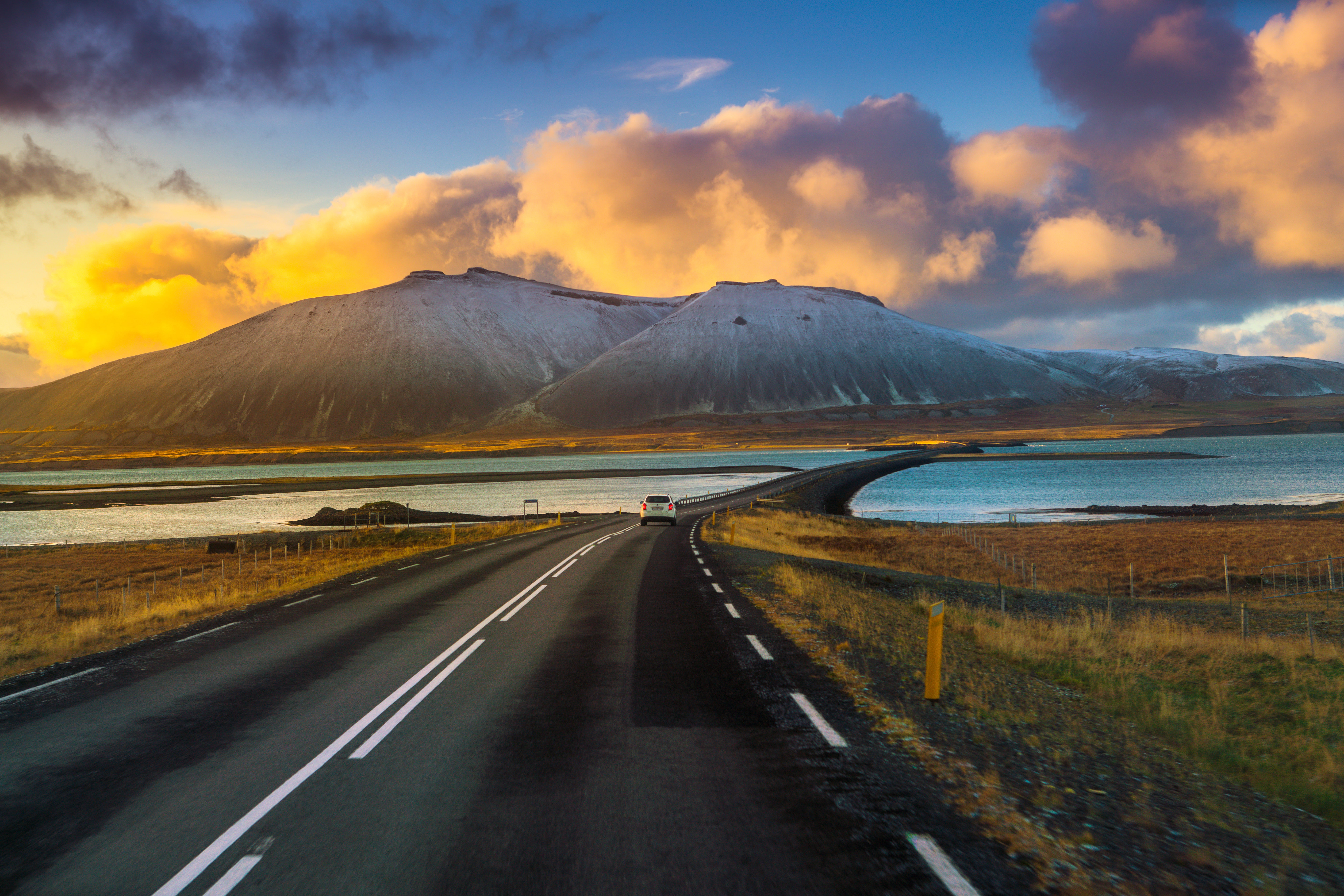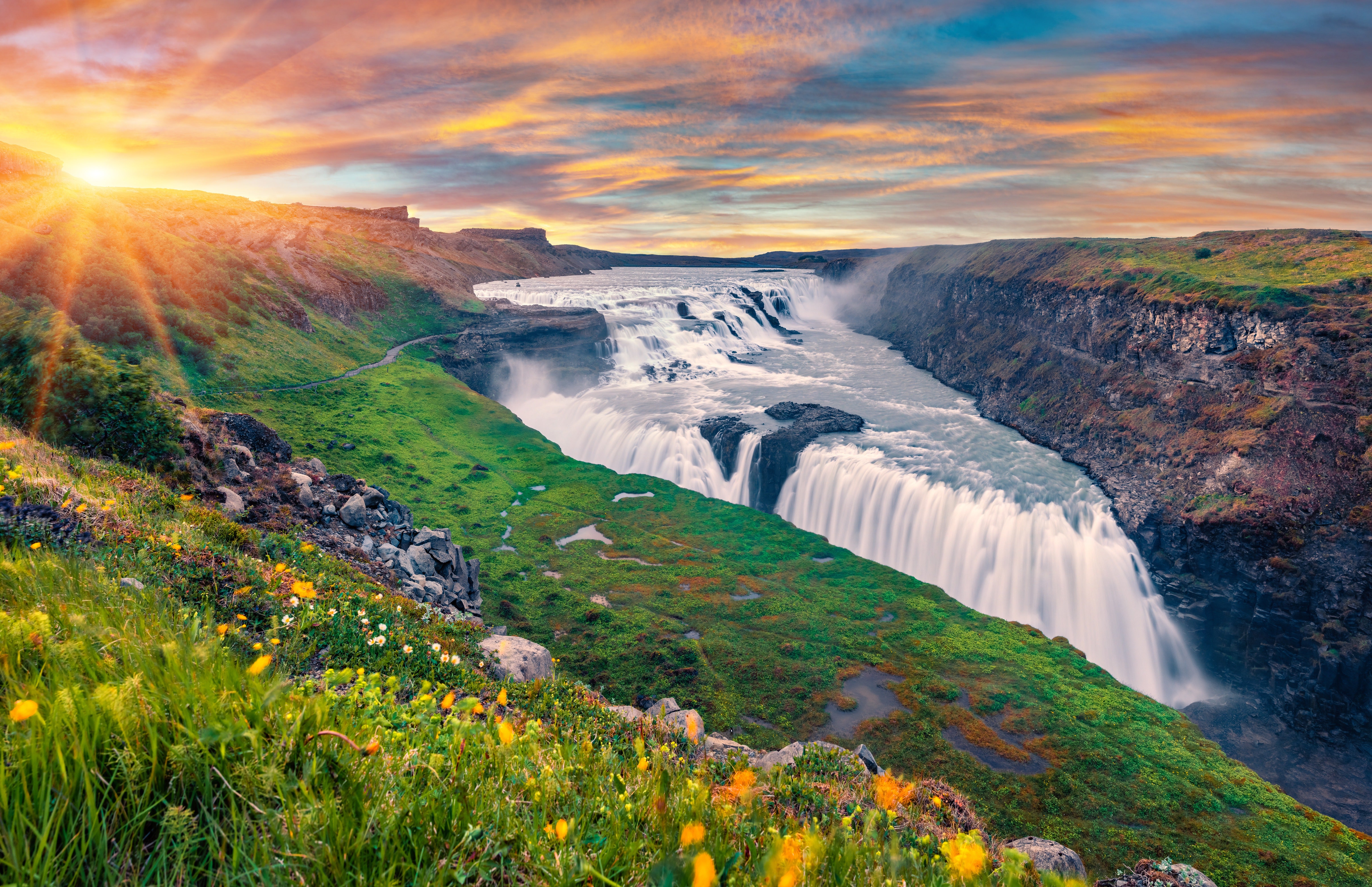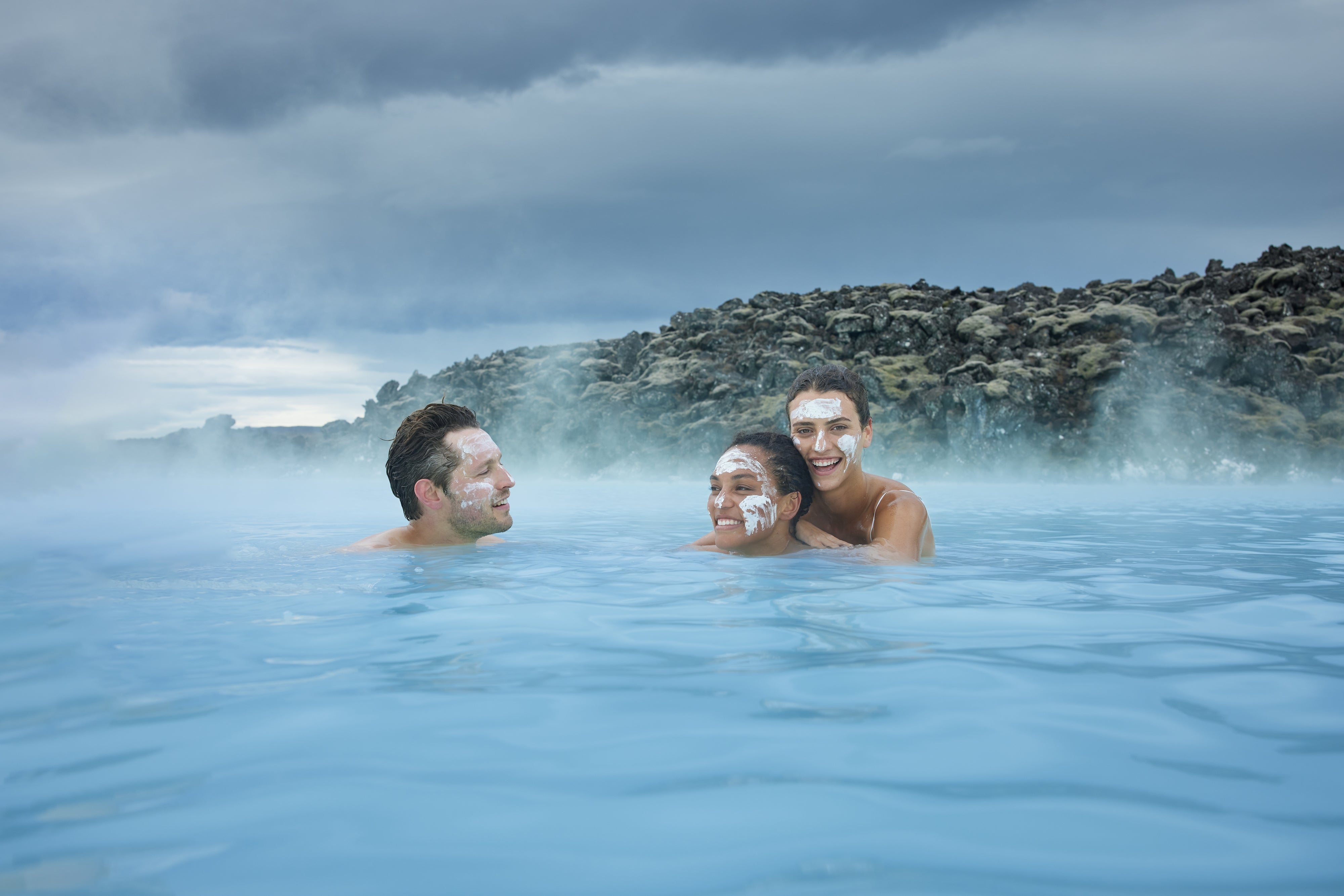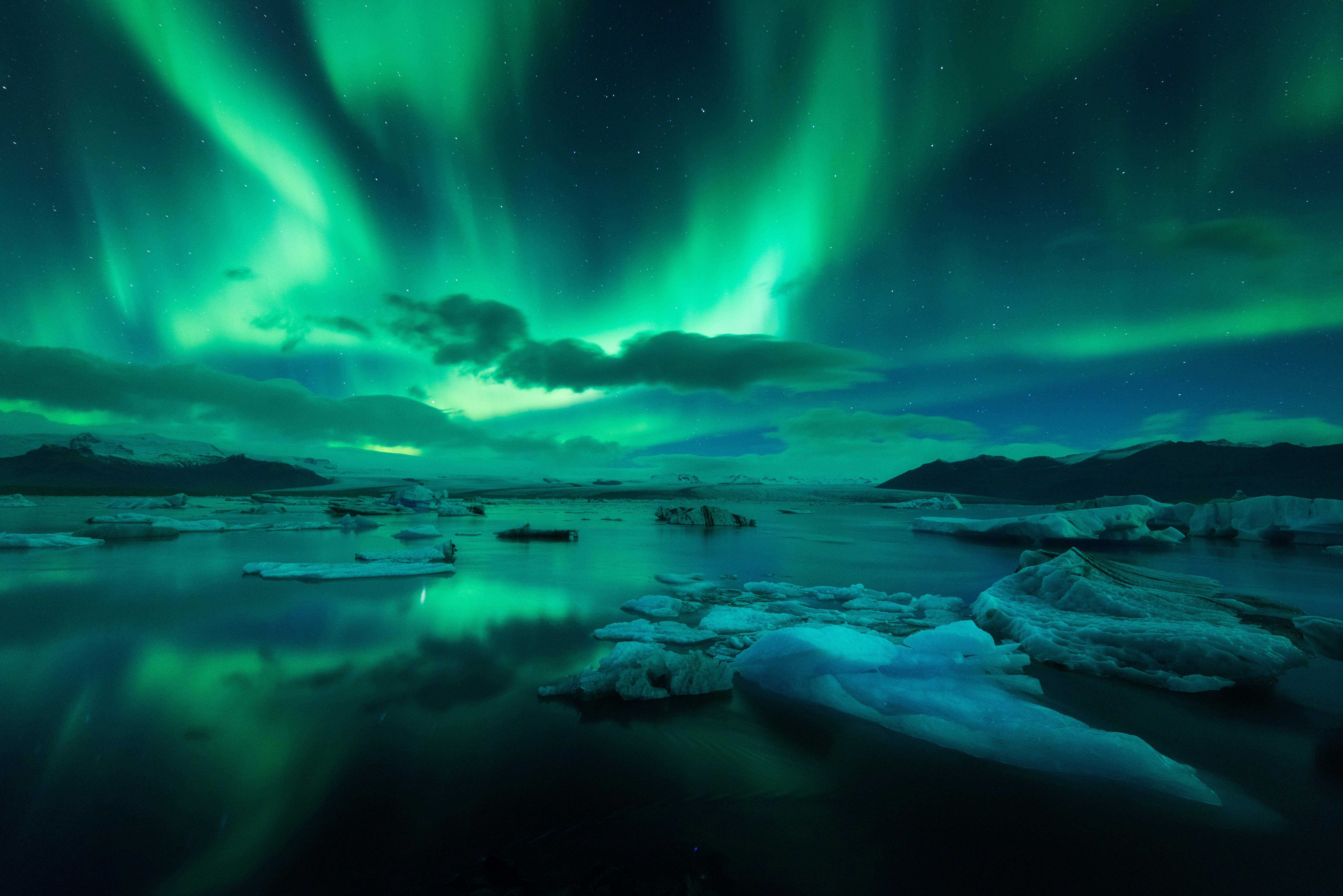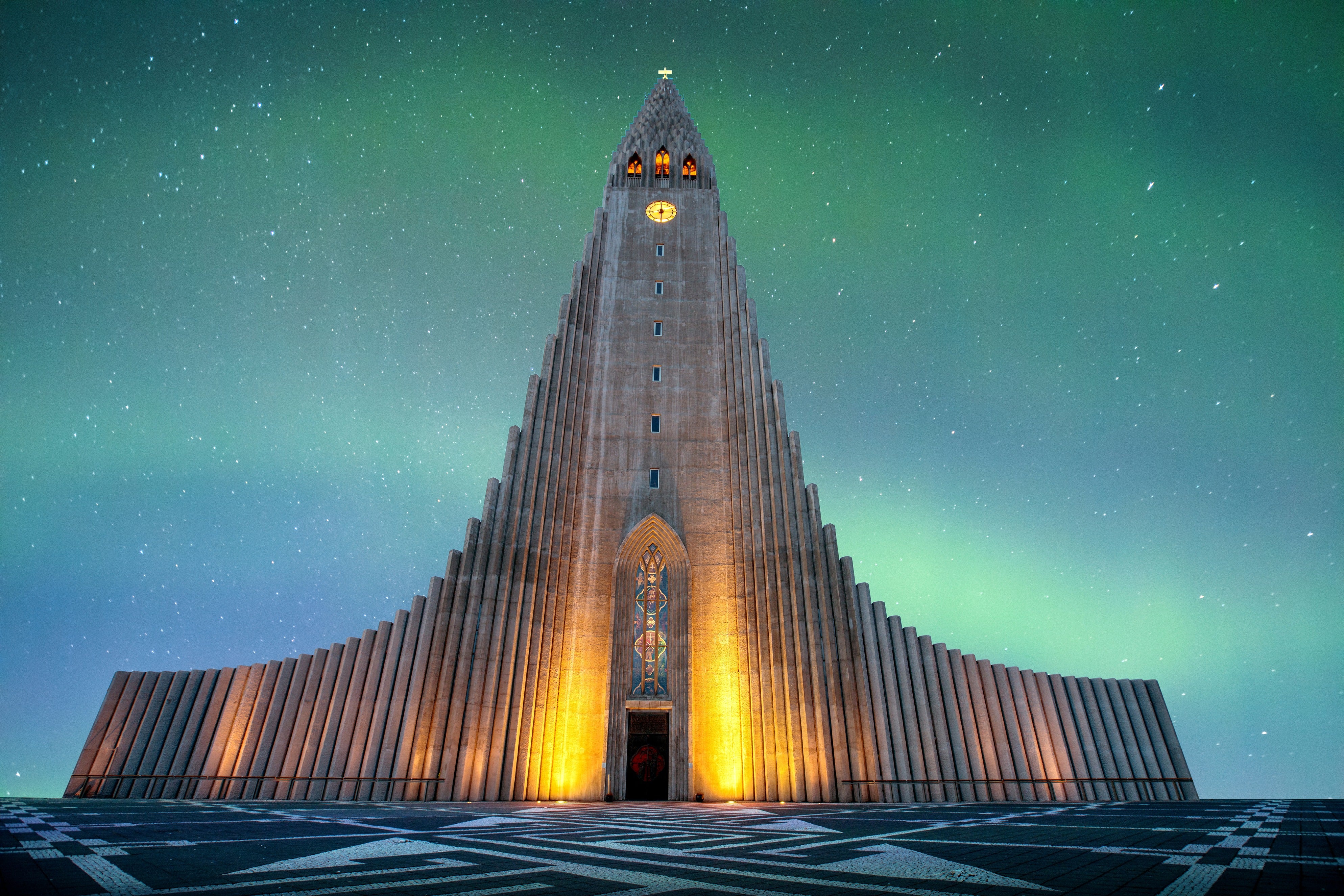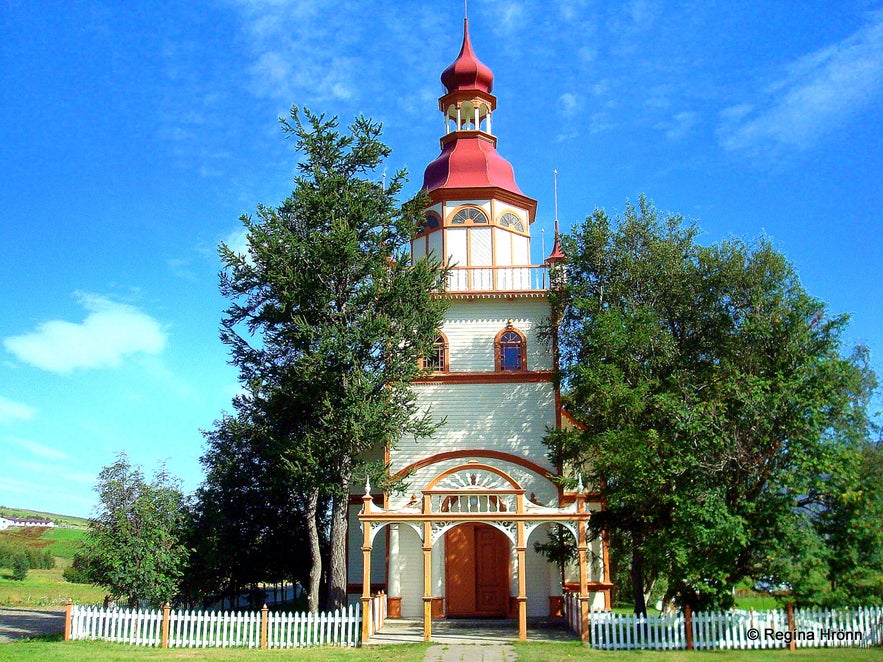
On my travels in Iceland I visit all the churches I encounter - and to visit some of them I travel long distances. There are several historic churches in Eyjafjörður fjord, the longest fjord in North Iceland.
In this travel-blog I am going to show you 6 of them, the church at Grund, Saurbæjarkirkja turf church, Hólakirkja church, Munkaþverá church, the church at Möðruvellir, and Kaupangskirkja church.
These churches are in Eyjafjarðarsveit, and belong to the Laugalandsprestakall parish.
Top photo: Grundarkirkja church
Grundarkirkja church
Inside Grundarkirkja church
The church at Grund is ever so beautiful and different from most other churches in Iceland in that it has a spear tower.
At Grund, there has been a church since ancient times and the first mention of a church here at Grund was in the year 1106. Back in Catholic times in Iceland, the church was dedicated to St. Laurents.
The present church was built in 1905 by the farmer, Magnús Sigurðsson, for his own money and thus belonged to him. He cut its window panes himself, but a head carpenter, Ásmundur Bjarnason, drew the church.
It is the biggest church in Iceland built by an individual. It was a farm church until 2012, when it was donated to the parish.
Photo taken at the National Museum of Iceland of the chair of Þórunn, the mistress at Grund
Ancient church relics from Grund are now kept at the National Museum of Iceland, including a chalice from the 15th century and an exquisite chair from before the year 1550, from when Þórunn Jónsdóttir was the mistress at Grund.
She was the daughter of Jón Arason, who was the last Catholic bishop at Hólar in Hjaltadalur, beheaded in 1550 at Skálholt.
I took the photo above of the chair of Þórunn on one of my visits to the National Museum of Iceland in Reykjavík. It is carved in birch and is the property of the National Museum of Denmark.
The photo below of the chalice I also took at the National Museum. It is behind glass, so the photo is grainy.
The chalice from Grundarkirkja - I took the photo at the National museum
The chalice dates back to 1489 and is the oldest dated artifact at the National Museum. Engraved in it are images from the Passion of Christ. The matching paten (plate) has an engraved cross.
One can walk up the stairs and open a door to the balcony of the Grundarkirkja church and from there, you have a great overview of this lovely church. And don't forget to sign the guest book :)
The last time I visited Grundarkirkja church it was locked, as there has been vandalism and theft in our churches, so now most of the churches in Iceland and locked.
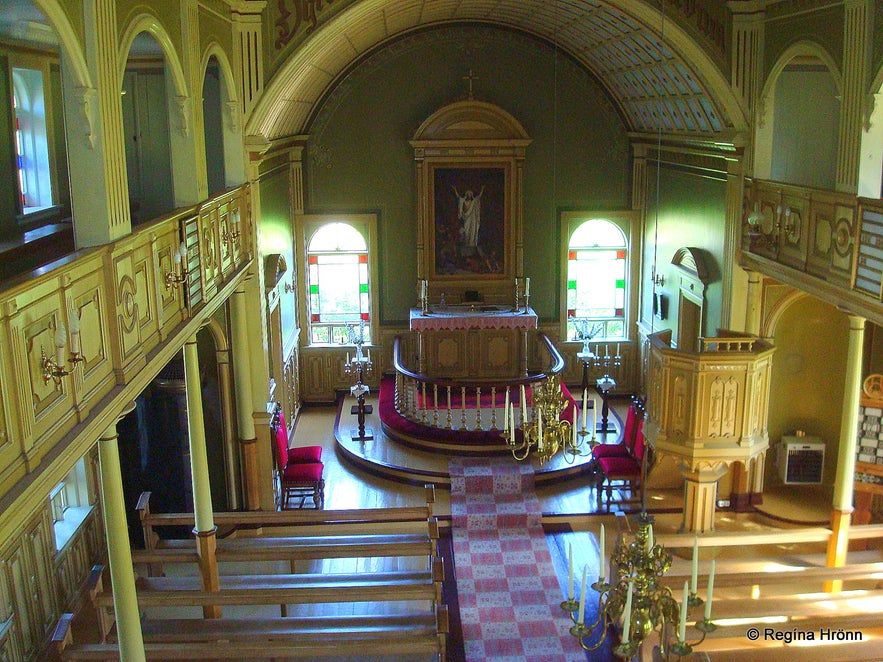
Inside Grundarkirkja church
Grund used to be one of the most prominent manors of Eyjafjörður and here lived Chieftain Sighvatur Sturluson, who got killed in Örlygsstaðabardagi battle in 1238, the biggest Viking battle in Iceland.
He was the brother of the well-known Chieftain Snorri Sturluson, who has been called the most influential Icelander ever. Later on, Sighvatur's son, Þórður kakali, lived for a while at Grund.
Grundarkirkja church, being such a historic church, is declared protected.
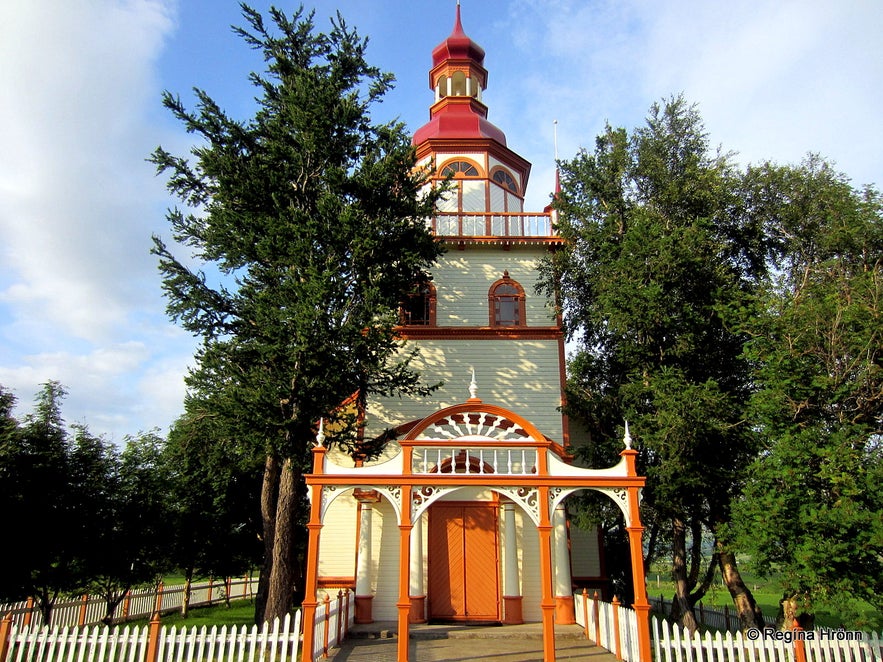
Grundarkirkja church
This beautiful church is located in Eyjafjörður on road 821 a little bit further away than Hrafnagil and the Christmas House, some 20 km away from the Capital City of the North - Akureyri.
It stands on one's left-hand side and is only a 2-minute drive from the road.
The owners of the church at Grund donated the church to the National Museum in 2012.
Saurbæjarkirkja turf church
Saurbæjarkirkja turf church
In the innermost part of Eyjafjörður, you will find Saurbæjarkirkja turf church, which is one of the few turf churches left in Iceland and the biggest one of the original turf churches.
I have dedicated a special travel-blog to Saurbæjarkirkja turf church, as these few remaining turf churches in Iceland are pure gems.
There is only a handful left of these beautiful turf churches in Iceland, but in the olden days, all the churches in Iceland were made of turf.
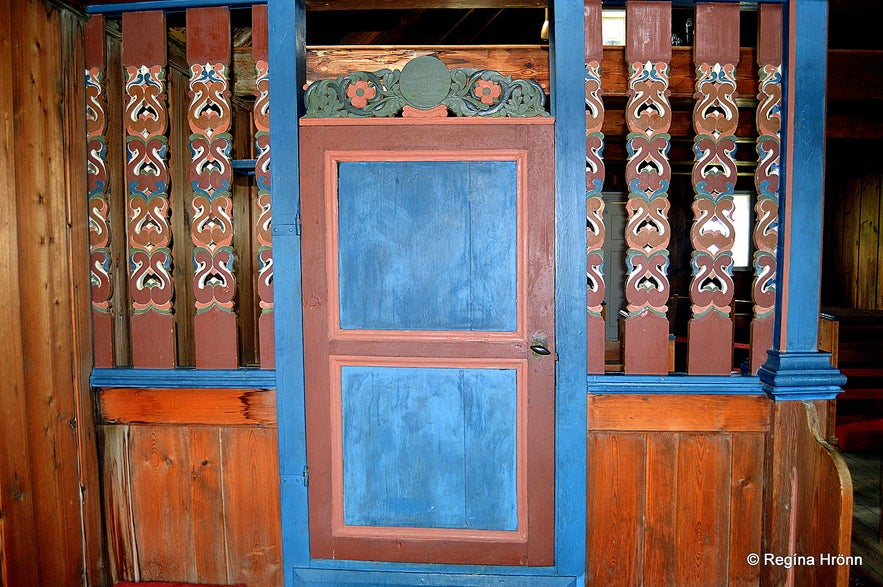
Inside Saurbæjarkirkja church
Saurbæjarkirkja was erected in 1858 and reconstructed in 2003.
The church is made of turf, rocks, and wood and a concrete cellar was added in 1960. Due to the natural building material, the turf churches and turf houses in Iceland need constant maintenance.
There have been churches at Saurbær since the early days of Iceland, and the churches were dedicated to St. Nicolas and St. Cecilia.
At Saurbær the remains of one of 14 of Iceland's convents have been found, it was founded around the year 1200.
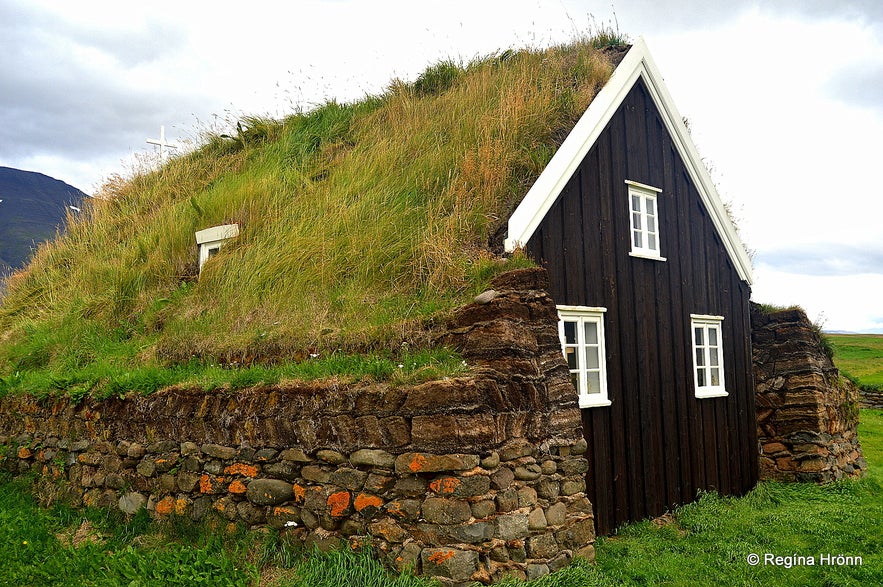
Saurbæjarkirkja turf church
Saurbæjarkirkja church is located by road 821 just above Smámunasafnið Museum - the Sverrir Hermannsson's Sundry Collection, from where you can get the key to the church in the summertime. It might be closed to visitors by now.
Now, let's cross the river and visit Hólakirkja church on road 826.
Hólakirkja church
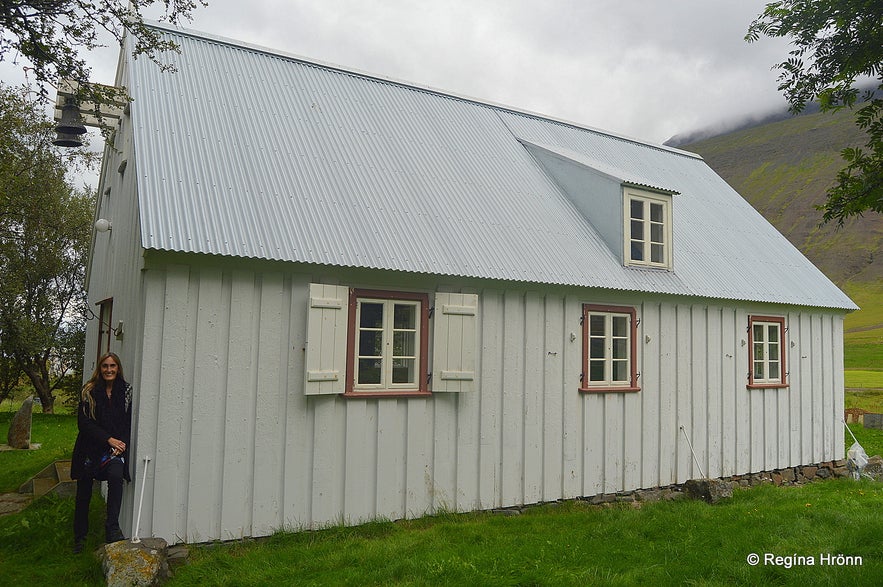 Hólakirkja church
Hólakirkja church
Hólakirkja church is the innermost church in Eyjafjörður (I hope I am saying this right, or is it outermost?) It is a small timber church like so many of the farm churches in Iceland.
The current Hólakirkja church replaced an old turf church from 1774.
This lovely little church was consecrated in 1853, in 1862 it was heated, maybe the first heated church in Iceland, and in 1882, a singer's balcony was added to the church. In 1991-1995 Hólakirkja church was completely renovated.
I was in luck when I visited Hólakirkja and the farmer lent us the key to have a look inside.
 Inside Hólakirkja church, the light was not favourable
Inside Hólakirkja church, the light was not favourable
Believe it or not, this small church seats 120 people. I would love to visit it during mass.
From what we believe there has been a church at Hólar since the beginning of Christianity in Iceland.
Víga-Glúms Saga tells us that Þorsteinn, the brother of Víga-Glúmur, lived here at Hólar in the 10th century.
These brothers were the great-grandchildren of Helgi magri and Þórunn hyrna, the first settlers of Eyjafjörður. I told you about them in my Akureyri travel-blog.
 The old triptych in Hólakirkja
The old triptych in Hólakirkja
Hólakirkja was dedicated to John the Baptist. The old triptych shows us the Last Supper.
Hólakirkja - the Hills Church most likely got its name from Leyningshólar and Hólahólar hills which you can see just a little bit further on.
These hills were created in the last Ice Age. And here you will also find the oldest remains of a birch forest in this area.
 Inside Hólakirkja church, there are several beautiful artifacts in the church
Inside Hólakirkja church, there are several beautiful artifacts in the church
And if you drive just a little bit further down this road you will reach Lake Hólavatn where YMCA runs a summer camp. A lovely place.
Next, we are going to visit the historic Möðruvellir on road 829.
Möðruvallakirkja church in Eyjafjörður
Möðruvallakirkja church
Möðruvallakirkja church is one of two churches with the same name in this area, this one is called Möðruvallakirkja in Eyjafjörður and the other one is called Möðruvallakirkja in Hörgárdalur valley, north of Akureyri.
The current church at Möðruvellir in Eyjafjörður was built in 1847 and consecrated in 1848. It has no tower but a big wooden cross.
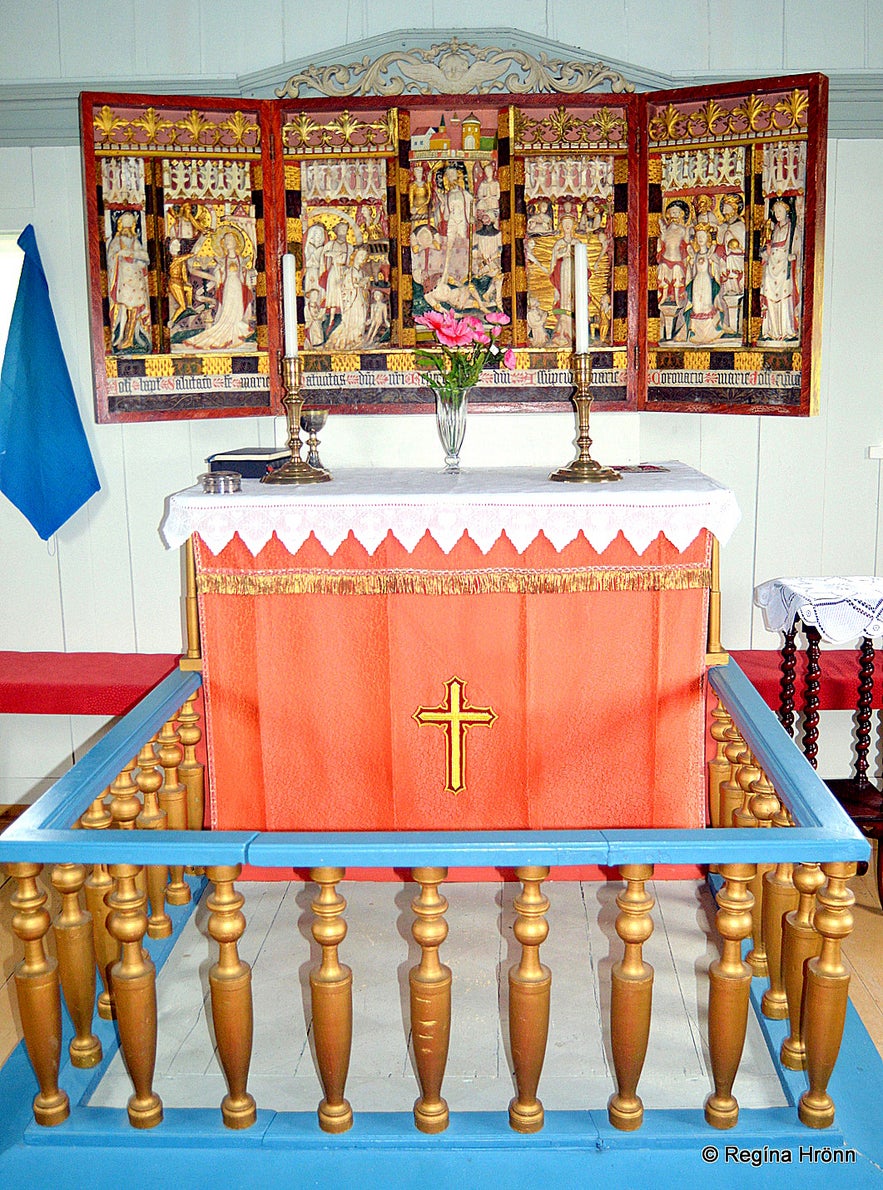
Inside Möðruvallakirkja church
The most precious relic in Möðruvallakirkja church is an altarpiece (triptych) from Nottingham, England, made of alabaster, and donated to the church in 1484.
It is a true masterpiece and I was surprised to see such an old altarpiece still in the church and not at our National Museum. It is lovely seeing such an old altarpiece in a country church.
Catholic churches at Möðruvellir were dedicated to St. Martin.

It was impossible to get a good photo of the triptych due to the light
The belfry at Möðruvellir, dating back to 1780, is the only one left of its kind in Iceland. The bells are also old, dating back to 1769, 1799, and 1867.
The belfry is preserved and has belonged to Þjóðminjasafnið - the National Museum of Iceland since 1962, but the church itself belongs to the farmer at Möðruvellir.
The best-known farmer at Möðruvellir must be Guðmundur ríki Eyjólfsson - or Guðmundur the wealthy, about whom you can read in many of our Sagas, f.ex. Ljósvetningasaga. His brother Einar, lived at Þverá, the next church I am going to show you.
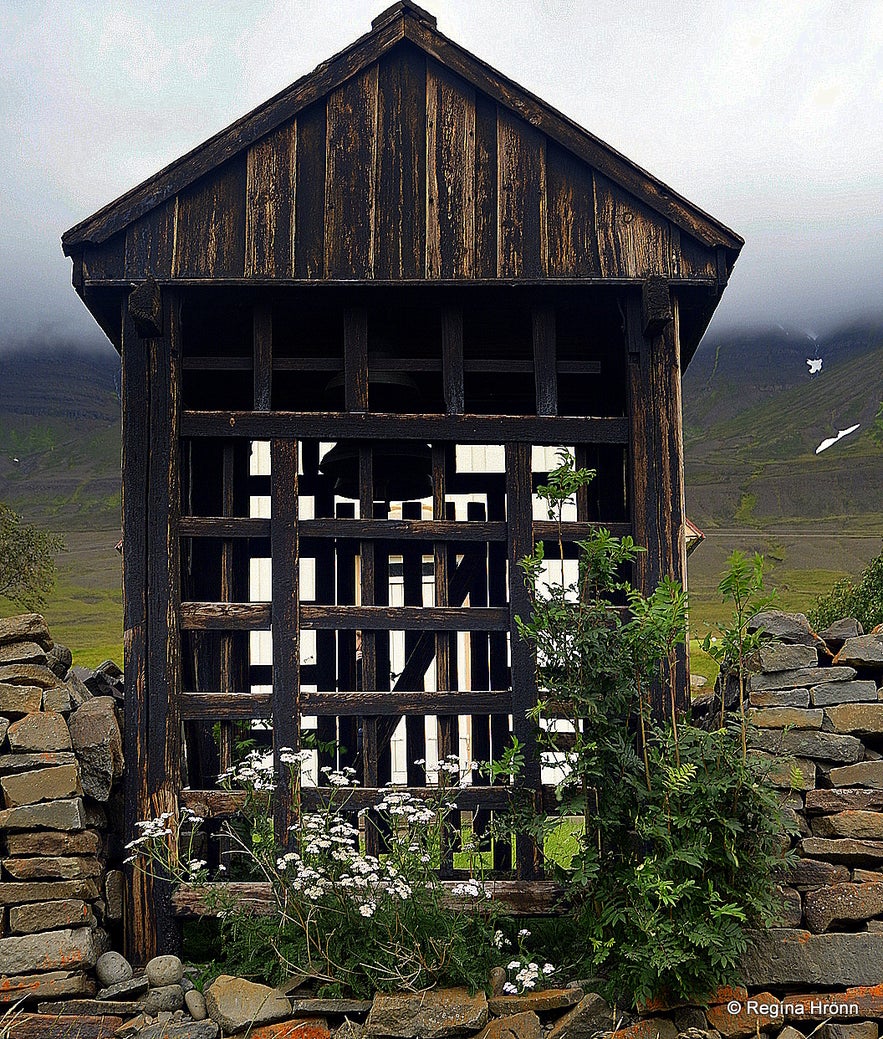
The preserved belfry at Möðruvellir in Eyjafjörður
My husband has the "job" of asking the farmers for the keys to the churches, that is why you see me standing in front of the church door in the first photo, waiting for him to come back with the key ;)
Now, let's drive further on to the next church, which is also by road 829. You turn from the road and drive down a hill that leads to the farm and the church.
Munkaþverárkirkja church
Munkaþverárkirkja church
At Munkaþverá a monastery operated for 396 years from 1155-1551, but in 1429 the monastery and the church burnt to the ground with a lot of valuables and 2 priests died.
The present church at Munkaþverá was erected in 1844 by Þorsteinn Daníelsson at Skipalón.
The church is so beautiful on the inside, very decorative with a rainbow painted from the altarpiece on the whole ceiling.
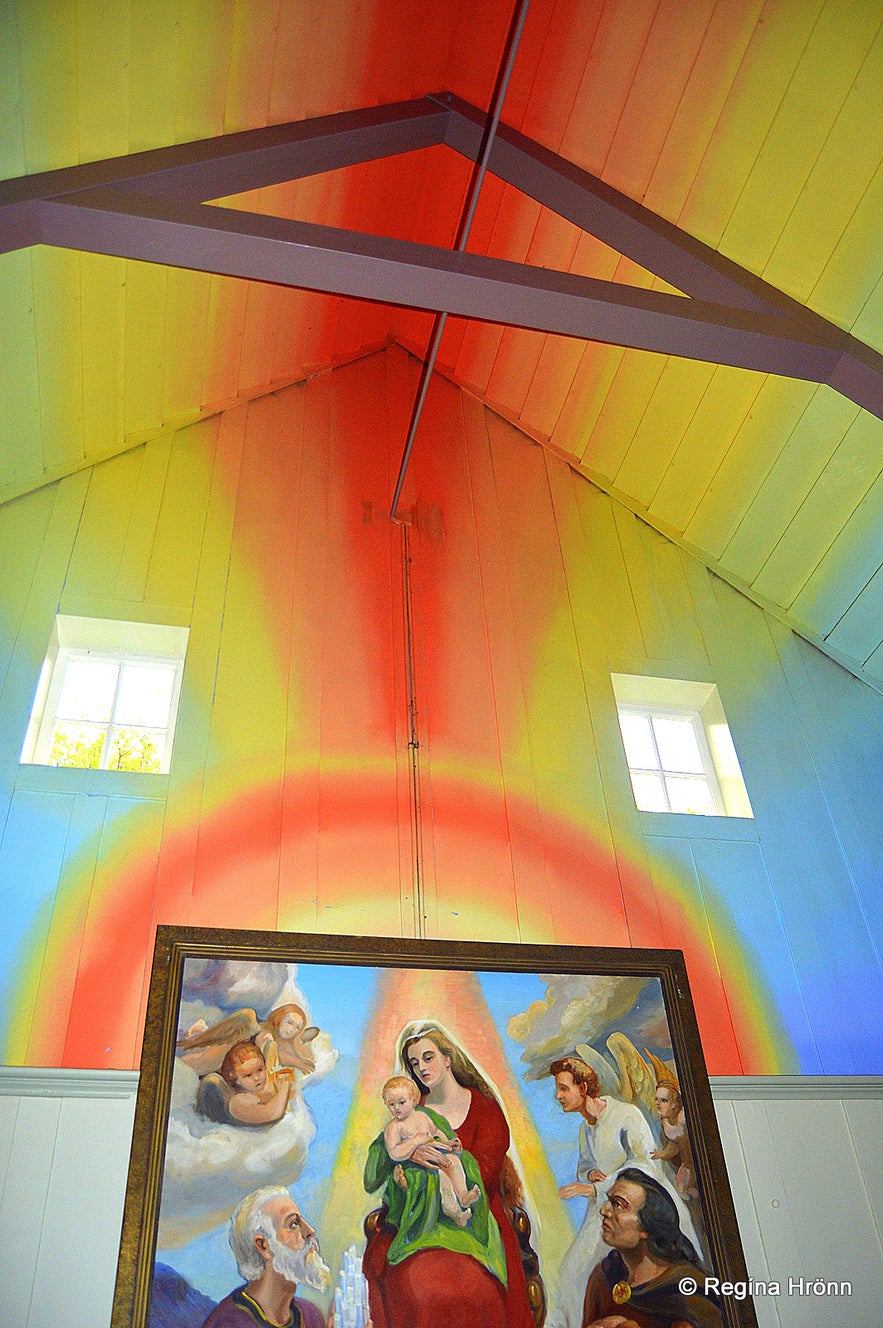
Beautiful Munkaþverárkirkja church
Munkaþverá, former Þverá or Efri-Þverá, was in the olden days one of the best lands in Iceland, and here lived Ingjaldur, the son of Helgi magri and Þórunn hyrna, the settlers of Eyjafjörður, whom I have told you about in my Akureyri travel-blog.
And it was the home of Víga-Glúmur, the protagonist of the Saga of Víga-Glúmur.
He was the grandson of Ingjaldur who settled at Þverá and who had built a large heathen temple here.
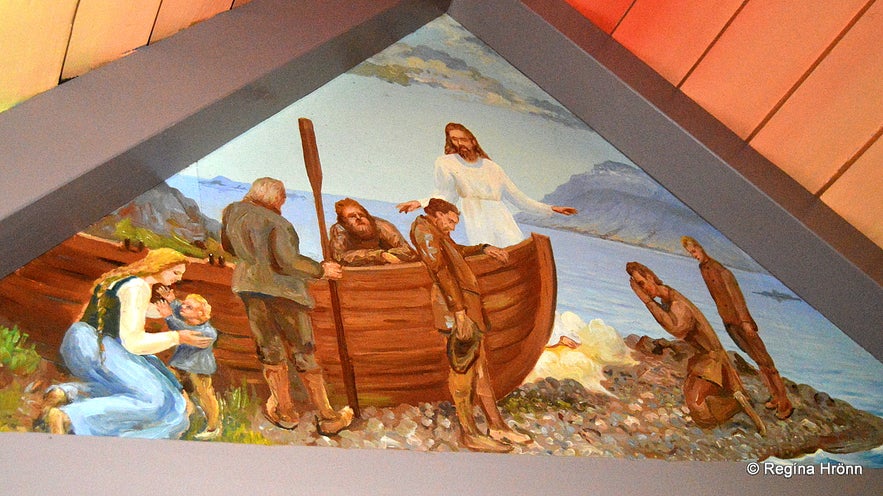
In one corner of the ceiling, I saw this beautiful painting
Einar Þveræingur, the brother of Guðmundur the wealthy, also lived here at Þverá.
He came into the possession of Þverá from his kinsman Víga-Glúmur, not that Víga-Glúmur was happy with moving away from the home of his ancestors though.
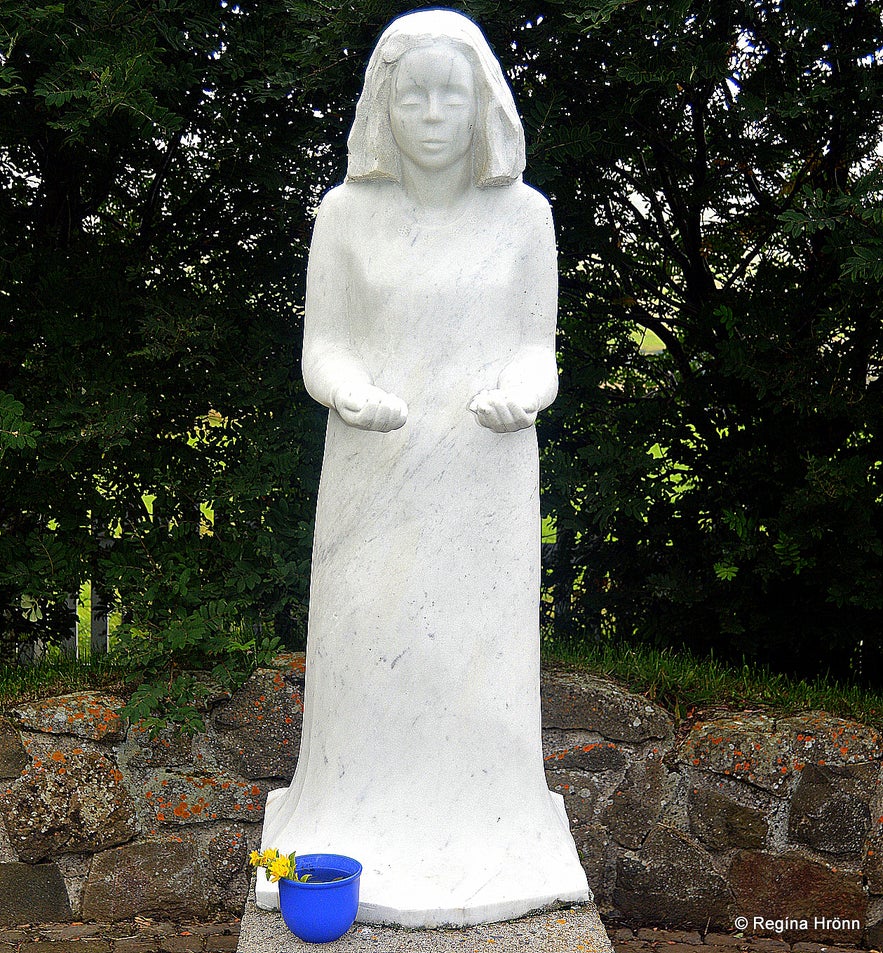
A statue of the Virgin Mary at Munkaþverá
You will find a statue of the Virgin Mary at Munkaþverá, erected in the year 2000 in remembrance of the 1000 year anniversary of the adoption of Christianity in Iceland.
The Munkaþverá church was dedicated to the Virgin Mary back then when the nation was Catholic.
In the graveyard, a Sturlungareitur - Plot of Sturlungar - is to be found, where Chieftain Sighvatur Sturluson of the Sturlung Clan and his sons are buried.
They got killed in the biggest Viking battle in Iceland - the Örlygsstaðabardagi battle - which took place between the biggest Viking clans in Iceland in 1238 in Skagafjörður.

The statue of Jón Arason at Munkaþverá
On the site of the old monastery, you will find a statue of Bishop Jón Arason, the last Catholic bishop in Iceland.
Jón Arason studied to become a priest here at Munkaþverá.
His daughter lived at Grund, where the beautiful Grundarkirkja church stands today, which I showed you here earlier in this travel-blog.
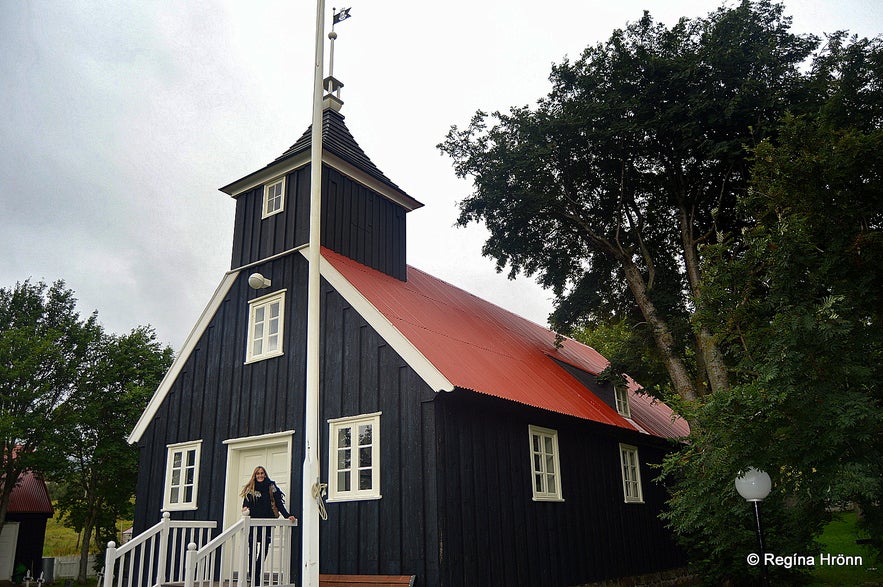
By Munkaþverárkirkja in Eyjafjörður on a cold and cloudy day
Munkaþverá is located in Eyjafjörður fjord on the east side of the Eyjafjörður fjord.
We will now drive further on road 829 and visit the last church, Kaupangskirkja church.
Kaupangskirkja church
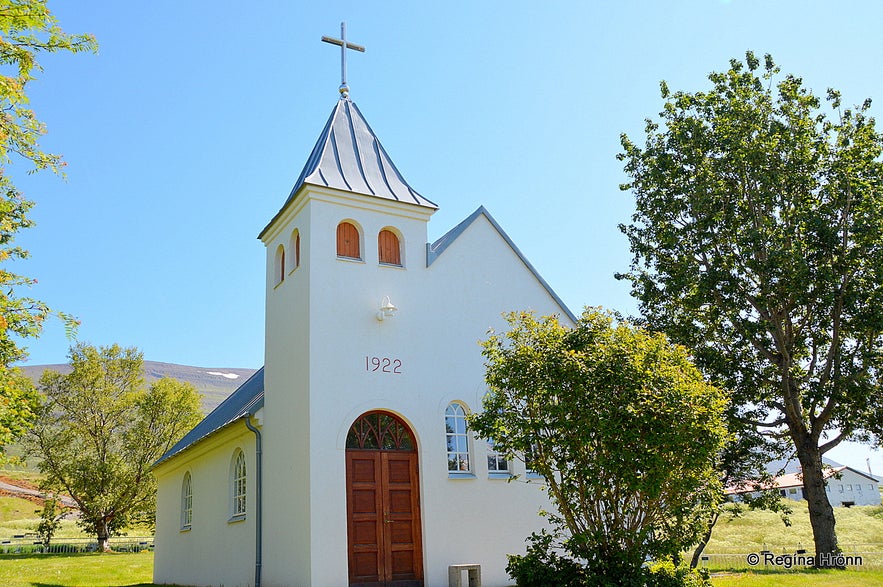 Kaupangskirkja church on a summer day
Kaupangskirkja church on a summer day
The first mention of a church at Kaupangur is in Auðunnarmáldagi - the Muniments of Auðunn dating back to 1317. We believe that this might be one of the oldest church sites in Iceland.
The current stone church, which replaced a delapidated timber church, was consecrated in 1922, which makes it the youngest of the churches in Eyjafjarðarsveit.
It has a distinct shape as the church tower is not in the middle of the church but to the left, i.e. in the northwest corner of the church.
Kaupangskirkja church is not mentioned in the Kirkjur Íslands - the Churches of Iceland series of preserved churches in Iceland, which I own and use as a reference when writing my travel-blog.
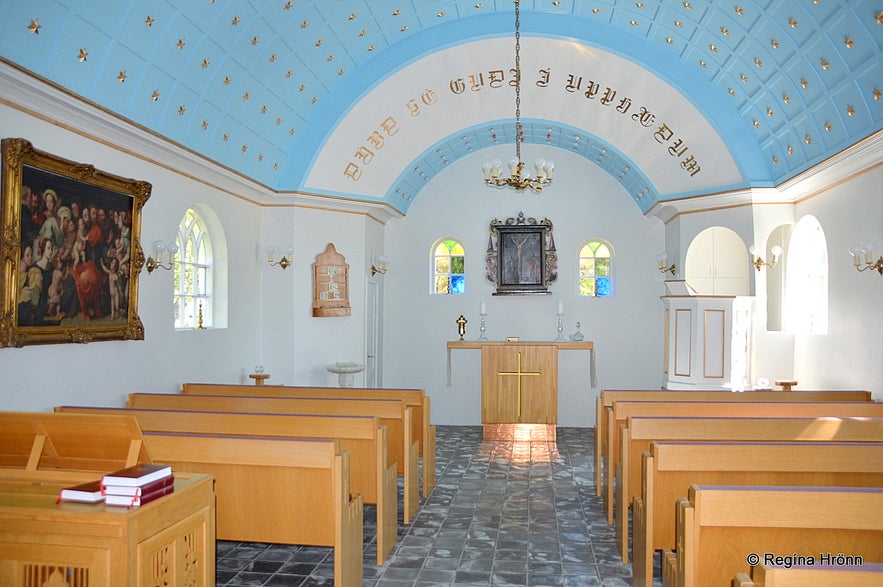 Inside Kaupangskirkja church
Inside Kaupangskirkja church
Kaupangskirkja hadn't turned 100, so to speak, when this series of books was published, but that is a prerequisite for being mentioned in these books, and all churches and houses in Iceland that reach this age are preserved.
Kaupangskirkja church has reached that age now and is thus preserved.
When this church was Catholic it was dedicated to the Virgin Mary like Munkaþverárkirkja church, and to King Olav the Holy (Ólafur helgi).
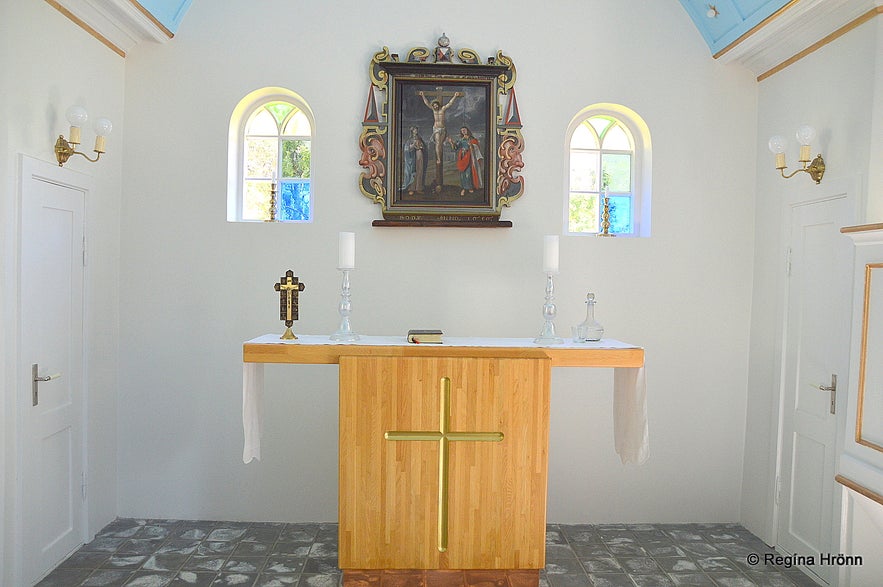 The simple altar and the old altarpiece in Kaupangskirkja church
The simple altar and the old altarpiece in Kaupangskirkja church
The interiors of the church, which seats around 90 people, were refurbished in 1988, it got a new altar, new pews, and new tiles on the floor. That same year it got reconsecrated.
I took a wobbly video of the surroundings of Kaupangskirkja church from the road. My husband was fetching the mail for the farmer, a woman who was on crutches, and you can see him returning to the road in my video.
When we had asked her for the church key, she sighed and asked us if we stole hymn books! We certainly don't, but that has, apparently, been an issue in this church, that people have taken hymn books :(
Let's always respect the holiness of the churches and never take anything away from them.
Now, this concludes my journey of the churches in Laugalandsprestakall parish in Eyjafjörður fjord, and I hope you have learnt something from reading my travel-blog and that it will enrich your travels in North Iceland.
Eyjafjörður fjord is filled with interesting places to visit - and there are many more interesting churches in this long fjord, all of which I have visited.
I hope you enjoy exploring Eyjafjörður fjord with me :)
Eyjafjörður fjord up North - part I - Hrísey Island, the Pearl of Eyjafjörður
Eyjafjörður fjord up North - part II - Dalvík & the Great Fish Day
Eyjafjörður fjord up North - part III - the Historic Gásir and the Vikings
Eyjafjörður fjord up North - part IV - The Deacon of Dark River - A Ghost Story from North Iceland
Eyjafjörður fjord up North - part V - Mt. Hraundrangi in Öxnadalur and Hörgárdalur Valleys
Eyjafjörður fjord up North - part VI - Akureyri - the Capital City of North Iceland
Eyjafjörður fjord up North - part VII - the Christmas House is open all Year-round
You can either rent a car in Reykjavík, and drive up north to visit the beautiful churches in Eyjafjörður fjord. Or fly up to Akureyri and rent a car up north.
Have a lovely time in Eyjafjörður :)
Ref.:
Kirkjur Íslands
